
New World Quarantine Page Menu: 1 2 3 4 5 6 7 8 9 Next>>
New World Quarantine During the Golden Age of Piracy, Page 4
History of Small Pox
Like most diseases, the early history of small pox is somewhat vague; physician and infectious disease historian Donald Hopkins explains,
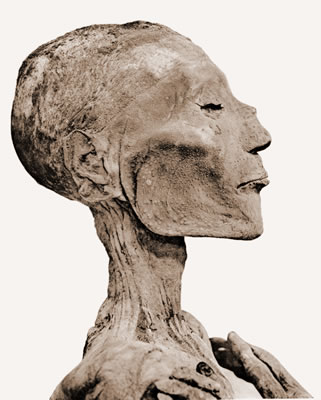
The Head of Ramses V, From Catalogue General Antiquities
Egyptiennes du Musee du Caire, By G. Elliot Smith (1912)
"the first human victim of smallpox probably lived in one of the earliest concentrated agricultural settlements in Asia or Africa, sometime after about 10,000 B.C."1 A group of researchers led by Frank Fenner suggest that smallpox "may have developed as a specifically human disease at any time after irrigated agriculture had allowed human populations to grow sufficiently large, perhaps some 6000 years ago."2
More specifically, Hungarian pathologist Gyula Regöly-Mérei suggested that the Ebers Papyrus, written between 3730 and 1555 BC, described a skin diseases which he thought could be smallpox, but Hopkins says that "these and other alleged descriptions are far too vague to provide any reasonable written evidence of smallpox in ancient Egypt."3 A World Health Organization publication on the history of smallpox notes that neither the bible nor the Talmud, both records including information on the Egyptian Valley of the Nile and the larger Fertile Crescent, make no mention of diseases which sound like smallpox.4 However, in the early 20th century paleopathologist Sir Marc Armand Ruffer uncovered three different preserved Egyptian mummies with skin eruptions which looked like smallpox. On the skin of one of these, 'a tall man of middle age' dating to 1200-1100 BC, Ruffer found a peculiar vesicular or bulbous eruption which in form and general distribution bore a striking resemblance to that of small-pox" on the right thigh.5 He also says that Professor Alexander Ferguson found well-marked pustular eruptions on the genitals, abdominal wall and face of Ramses V's mummy which were "highly suggestive of smallpox.6 Ramses died in 1157 BC.
1 Donald Hopkins, The Greatest Killer, 2002, p. 13; 3 Frank Fenner, Donald A. Henderson, Isao Arita, Zdenek Jezek & Ivan D. Ladnyi, Smallpox and its Eradication, 1988, p. 216; 3 Hopkins, Greatest Killer, p. 15-6; 34Fenner et al., p. 210; 5 Marc Armand Ruffer, Studies in the Palaeopathology of Egypt, 1921, p. 32; 6 Ruffer, p. 175
The Earliest Written References to Smallpox
As historical records became more plentiful, definitive descriptions of the disease began to appear. Joseph Needham and Lu Gwei-Djen state that the earliest such description is found in Chinese physician Ge Hong's Handbook of Medicines for Emergencies in 340 AD.1
Because the evidence found on the mummies and in the Ebers Papyrus is not conclusive, other evidence must be examined to place smallpox in the African continent.
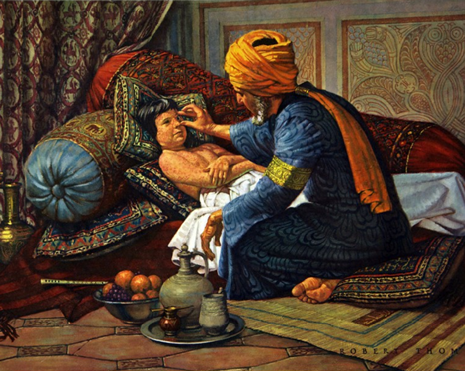
Artist: Robert Thom - Rhazes Tending a Child with Smallpox or Measles (1958)
The first explicit account of the disease there was "a treatise was written on the Small Pox by Ahrun of Alexandria" around 622 AD.2 This collection of thirty books by the Christian priest and physician was lost, but large parts of it are quoted by Persian physician Abu Bakr Muhammad Ibn Zakariya al-Razi (Al Rhazes) in his book A Treatise on the Small Pox and Measles in the late 9th or early 10th century.3 This book along with works by fellow Persian physician Abū ʿAlī al-Ḥusayn ibn ʿAbd Allāh ibn Al-Hasan ibn Ali ibn Sīnā (Avicenna) were seminal works on medicine which were translated into Latin in the 15th century, influencing European medical thought on the disease well into the golden age of piracy.4 (For more on the history of early books on medicine which impacted golden age of piracy medical thought, see this page.) From northern Africa, smallpox was carried into the Mediterranean, becoming endemic in the area during the 8th century.
As Arabs traded with places such as China, India and the upper western coast of Africa, they brought the disease with them. Smallpox was probably introduced to west African coastal towns in the eleventh century although it isn't recorded by Europeans until the seventeenth. "The slave trade provided excellent conditions for spreading smallpox, and since raiders penetrated deep into the interior the overland caravans carried the disease far and wide in central Africa. …there are numerous records of smallpox at the coastal camps and in the slave ships during the 17th and 18th centuries."5 The first recorded case of the disease in southern Africa occurred in 1713 when a ship returning from India docked at Cape Town, bringing the disease in their laundry.6
Clinical descriptions of what may have been smallpox appear in ancient Indian medical and religious texts according to Hopkins.
, From Nepal, Text Dated to 12-13c.jpg)
The Susruta Samhita Written on Palm Leaves, Nepal, (Text Dated to 12-13 century)
He points to physician Thomas Wise's English translation of the ancient Sanskrit medical text Susruta Samhita. "Part of the ...text is traditionally ascribed to the earliest known Hindu physician, Dhanwantari ...written some time before A.D. 400, and they may recount descriptions from as early as 1500 B.C."7 Wise notes that the disease is written as 'masúriká', 'masúri' or 'gutí' in Sanskrit.8 However, Ralph Nicholas points out that while "masúriká is certainly the term used to designate smallpox in later texts... [the Susruta Samhita says] extremely little about masúriká"9. As proof, he cites the 1911 interpretation of the book by Kaviraj Kunja Lal Bhishagratna which says "Masuriká (variola) - The yellow or copper-coloured pustules attended with pain, fever and burning and appearing all over the body, on (the skin of) the face and inside the cavity of the mouth are called Masuriká."10 Curiously, he does not include any of the words in italics (added here for reference) which are found in the book, perhaps because they would weaken his point. Fenner and his researchers avoid the Susruta controversy by stating, "“The first extant description of masurika as a severe and sometimes fatal disease appears in the works of Vagbhata, a physician writing early in the 7th century AD."11 Vagbhata references the Susruta frequently in his books.
The first known reference to smallpox in Europe is often said to be a prayer to St. Nicaise, the Bishop of Rheims in the fifth century and the patron saint of smallpox victims. In the prayer, it states that the saint had smallpox.

Photo: Wiki User Urban - Stained Glass Showing the Life of St. Nicaise (13th century)
However, surgeon James Carrick Moore points out that the book The Lives of the Saints does not mention his having had the disease. Rather, "[a] saint was wanted to superintend this new disease, and Saint
Nicaise was accidentally pitched upon by the ignorant Monks; who, to justify their choice, asserted that he had a disease which did not appear in Europe till about three centuries after his death."12
In the fifteenth century, smallpox became endemic to many parts of Europe, being recorded as a disease in Parisian children. During the sixteenth century, it became well-established throughout Europe.13 "By the sixteenth century, multiple smallpox outbreaks in European countries were reflected by statistics then being collected in several large cities including London, Geneva, and Stockholm. "14 Writing in 1546, Italian physician Girolamo Fracastoro said that smallpox primarily affected children,15 suggesting it had been present there for some time. This is because when a society is first affected with smallpox, people of all ages contracted it, but once it was established, most of the people who survived childhood had acquired immunity and it became a disease which primarily affected children. Hopkins says "by the end of the seventeenth century, V[ariolus]. major [smallpox] had clearly succeeded plague, leprosy, and syphilis as the continent's foremost pestilence. Typhus, dysentery, and plague were still common killers of Europeans, but smallpox was now the most common."16 Because of the nature of the virus, it was endemic to the densely populated cities of Europe and Great Britain, although it appeared in the less populous countryside only every several years in epidemics.17 It was during the seventeenth and eighteenth centuries that smallpox became "the most devastating disease in the world, in Europe alone killing an estimated 400,000 people each year. One-third of all cases of blindness resulted from smallpox."18 More than five percent of the population of London were killed by smallpox between 1650 and 1699 according to the Bills of Mortality from that period.19
1 Frank Fenner, Donald A. Henderson, Isao Arita, Zdenek Jezek & Ivan D. Ladnyi, Smallpox and its Eradication, 1988, p. 216; 2 James Moore, The History of the Small Pox, 1815, p. 56; 3 Abú Becr Mohammed Ibn Zacaríyá Ar-Rází, A Treatise on the Small-Pox and Measles, Translated by William Greenhill, 1848, p. 163-4; 4 Fenner et al., p. 214; 5 Fenner et al., p. 233;6 Fenner et al., p. 234; 7 Donald Hopkins, The Greatest Killer, 2002, p. 16; 8 Thomas Alexander Wise, Commentary on the Hindu System of Medicine, 1845, p. 233; 9 Ralph W. Nicholas, "The Goddess Śītalā and Epidemic Smallpox in Bengal", The Journal of Asian Studies, Vol. 41, Nov 1981, p. 25; 10 Kaviraj Kunja Lal Bhishagratna, An English Translation of the Sushruta Samhita, Vol. II, 1911, p. 90; 11 Fenner et al., p. 214; 12 James Moore, The History of the Small Pox, 1815, p. 98; 13 Fenner et al., p. 229; 14 Michael B. A. Oldstone, Viruses, Plagues, and History, 2000, p. 30; 15 Fenner et al., p. 229; 16 Hopkins, The Greatest Killer, p. 32; 17 Fenner et al., p. 231; 18 Oldstone, p. 33; 19 Hopkins, The Greatest Killer, p. 37
Smallpox In the Spanish and Portuguese Occupied New World
"...smallpox was spread across oceans by mariners as well as over land routes by armies and caravans. These European explorers, and the colonists who soon followed to the newly-discovered continents of America, Australia, and South Africa, brought smallpox as part of their baggage." (Michael B. A. Oldstone, Viruses, Plagues, and History, 2000, p. 30)
According to German physician and medical historian
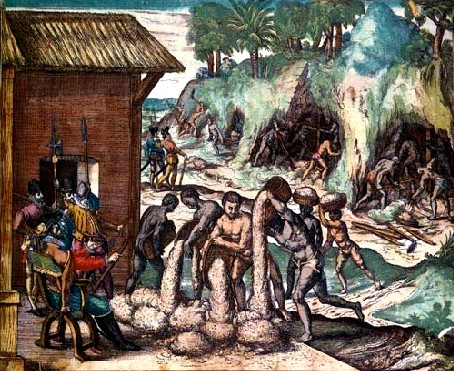
Artist: Theodor de Bry
Spaniards Supervising Slaves in Hispaniola, From America, Part V (1595)
August Hirsch, the first smallpox outbreak in the New World occurred in the West Indies in 1507.1 Hirsch doesn't provide any specifics about the outbreak nor does he give a period source for it, although Donald Hopkins says that it occurred in Hispaniola (modern Haiti).2 Dr. Hirsch says the next outbreak occurred in 1517, being "imported by the Spaniards into Hayti. The subsequent outbreaks in the West Indies are chiefly connected... with the importation of negro slaves."3 However, Hopkins notes that this outbreak was wider affecting 'several Spanish ports' during this period.4 During this second wave spread to Cuba in 1518 and Puerto Rico in 1519.5 With the disease present on these three Caribbean islands, "it was inevitable, in that age, that smallpox would spread to the
densely populated mainland of Central America"6.
The importation of African slaves by Europeans is frequently blamed for the spread of the disease into the New World.7 Slaves began to be brought to Hispaniola in 1503 with their importation was officially sanctioned by King Ferdinand II of Spain in 1510.8 One of the most renowned and devastating early instances of smallpox being introduced to the New World started with a slave. Infected African slave Francisco de Baguia was transported to Mexico from the Caribbean islands by Spanish conquistador Pánfilo de Narváez in April of 1520. Narváez was sent to Mexico in an effort to counter fellow conquistador Hernán Cortés. Along the way, they introduced the virus to Cozumel. They then proceeded to Cempoala, a city close to present-day Vera Cruz.9 Francisco Toribio de Benavente Motolinía gave a description of what followed in his History of the Indians of New Spain:
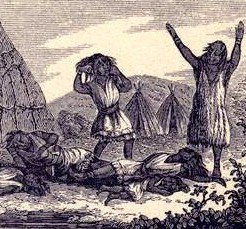
"Great Mortality Among the Indians", From The
History and Antiquities of New England, By
John Warner Barber, p. 471 (1841)
God struck and chastened with ten terrible plagues this land and all who dwelt in it, both natives and foreigners.
The first was a plague of smallpox... and when the smallpox began to attack the Indians it became so great a pestilence among them throughout the population died; in others the proportion was little less. For as the Indians did not know the remedy for the disease and were very much in the habit of bathing frequently, whether well or ill, and continued to do so even when suffering from smallpox, they died in heaps, like bedbugs. Many others died of starvation, because, as they were all taken sick at once, they could not care for each other, nor was there anyone to give them bread or anything else. In many places it happened that everyone in a house died, and, as it was impossible to bury the great number of dead, they pulled down the houses over them to check the stench from the dead so that their homes became their tombs.10
Because the majority of the Spanish and other Europeans had already survived smallpox after it had become endemic in their native countries, they were immune to the virus, while the natives were not. The result was catastrophic for the Central Americans. Thoroughly demoralized by their suffering, Cortés was able to easily defeat them. Smallpox continued to spread throughout Central America, spreading to Guatemala and the Yucatan peninsula during 1520 and 1521.
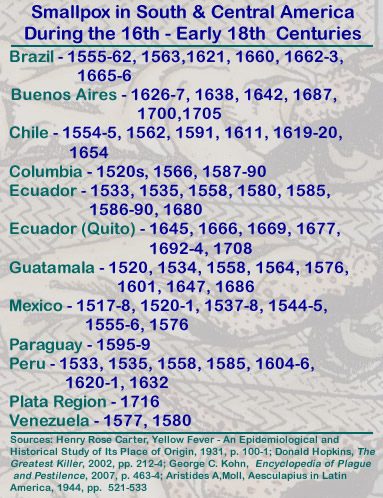
Smallpox Outbreaks in South America in the 16th Century
Image:
Bernardino de Sahagún, From the Florentine Codex (16th c.)
Between the conquistadors and the infection in Central America the illness spread to South America. The Incas of Peru contracted an illness which may have been smallpox around at some time between 1524 and 1527, likely having been brought to them from Central America.11 "These events so weakened the Incas that [Francisco] Pizarro and his small band entered Cuzco [Peru] in triumph in 1533, to be followed by further epidemics of smallpox."12 Multiple instances of small pox occurred throughout South America between the sixteenth and eighteenth centuries. A list of those identified by various historians can be found in the chart at left.
These outbreaks continued to devastate native populations. "By 1588, epidemics of smallpox erupted over the whole South American continent, and subsequently wave after wave of epidemic smallpox decimated the native populations."13 The loss of the native population resulted in increased demand for African slaves to work the plantations and mines in South America. Because many of them had been exposed to the virus in Africa, they were less susceptible to it than the Indians which the Spaniards had enslaved.14
Outbreaks continued to appear in the Spanish and Portuguese colonies of the New World into and beyond the golden age of piracy. Multiple outbreaks occurred in Brazil following the first large scale infection in 1621. Others Brazilian epidemics were recorded in 1631, 1642, 1662-3 and 1665-5.15 As with the previous outbreaks of smallpox, these proved to be most fatal to the native populations.
The 1665-6 epidemic also proved to be devastating to a 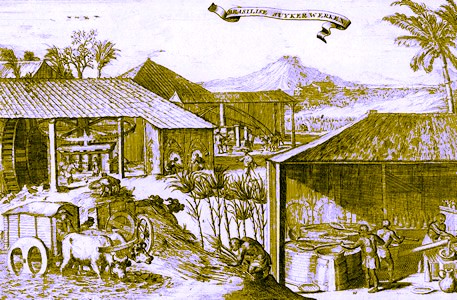
Artist: Simon de Vries - A Brazilian Sugar Mill (1682)
population of African slaves. Of this instance, historian Robert Southey explained that the illness broke out in Pernambuco and traveled along the southern coast of Brazil. On reaching the Salvador, it infected the slaves working at sugar mills in the Recôncavo baiano, an area where sugarcane and tobacco were grown. "Many Engehhos [sugar mills] in the Reconcave [Recôncavo] lost all their Negroes, and wealthy proprietors were thus at once reduced to irremediable poverty. So great was the mortality that hands were wanting for agriculture; many years of famine followed"16.
Hopkins mentions three smallpox epidemics in Chile and Guatemala each and seven in Ecuador during the seventeenth century.17 Similar smallpox outbreaks occurred every few years during the eighteenth century in South America as the virus became endemic, resulting in epidemics of the disease every few years. "Smallpox thus was almost uncontrolled in the Spanish colonies, except for quarantine, during most of the eighteenth century."18
1 Dr. August Hirsch, Handbook of Geographical and Historical Pathology, Vol. 1, Charles Creighton, translator, 1883, p. 136; 2 Donald Hopkins, The Greatest Killer, 2002, p. 204; 3 Hirsch, p. 137; 4 Hopkins, p. 204; 5 Frank Fenner, Donald A. Henderson, Isao Arita, Zdenek Jezek & Ivan D. Ladnyi, Smallpox and its Eradication, 1988, p. 236; 6 Hopkins, p. 205; 7 Hirsch, p. 136; 8 Hopkins, p. 204; 9 Hopkins, p. 205; 10 Toribio Motolinía, History of the Indians of New Spain, Translated and edited by E. A. Foster, 1950, p. 38; 11 Hopkins, p. 208; 12,13 Fenner et. al, p. 237; 14 Hopkins, p. 216; 15 Hopkins, p. 216-7; 16 Robert Southey, History of Brazil, Vol. 2, p. 555; 17 Hopkins, p. 218; 20 Hopkins, p. 220

